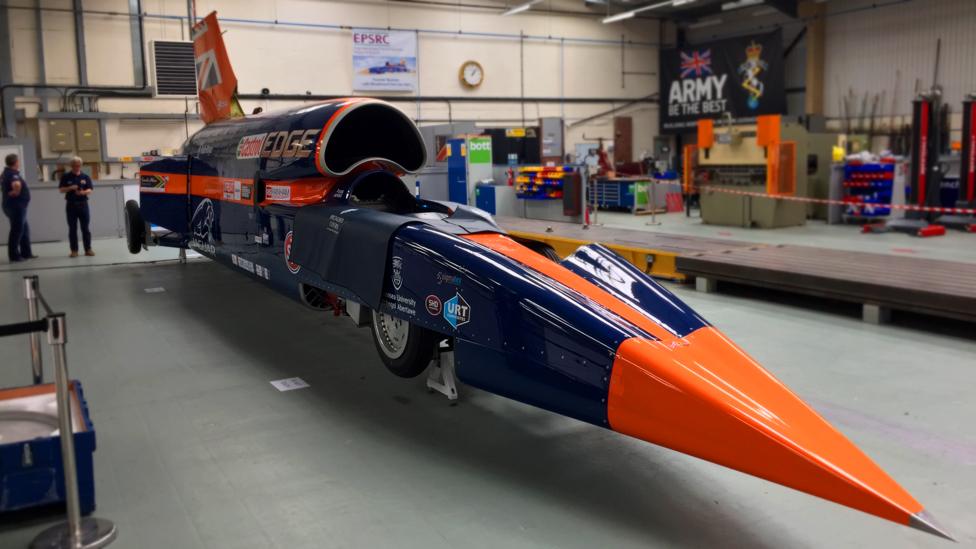Bloodhound supersonic car project back on track
- Published

The car will be stripped down from its initial build and then re-assembled ready to go racing
The Bloodhound supersonic car project is back on, and now aims to break the land speed record in October 2017.
Vehicle development had been on hold in recent months because of a shortage of cash, but new sponsorship deals mean engineers can now resume their work.
October 2017 will mark the 20th anniversary of the current land speed record - 763mph (1,228km/h), which was set by Thrust SSC in the US desert.
Bloodhound, external intends to raise this to 800mph, running in South Africa.
The new sponsors are not immediately being identified, but their support puts the British project on a solid financial footing.
"We now have the most vision of forward-funding that we've ever had," said components chief Conor La Grue.
"In the past, we've only ever really had funding to plan two to three months ahead.
"We're now in a position to go all the way through to taking the record."
Conor La Grue (L) and Mark Chapman (R) lay out the new schedule

The Nammo company is providing the rocket for Bloodhound
Engineers that were let go during the hibernation are being brought back; outstanding components needed to fully finish the vehicle are being ordered.
The near-complete car was showcased at Canary Wharf in London last September.
Since then it has been sitting largely untouched at Bloodhound's technical HQ in Bristol.
Now, it will be stripped down from its initial "dry build" and then reassembled, with fluids, ready to go racing.
A key task is to complete the development of the vehicle's rocket system.
Bloodhound will be using a Eurofighter-Typhoon jet engine to get itself rolling and to reach speeds in the low hundreds (mph), but it will need a booster to take it through the sound barrier and on to 800mph.
The rocket itself is being sourced from the Nammo company in Norway, but it will use a Bloodhound-designed gearbox and pump driven by a Jaguar V8.
Testing of these elements all operating together will be conducted in the autumn.

Newquay's runway will be used for some low-speed runs a year from now
The team intends to employ the rocket in a monopropellant configuration. This means no fuel grain is burned in the motor.
To produce thrust, concentrated hydrogen peroxide is merely pumped at pressure across a catalyst, where it decomposes into steam and oxygen. The hot gases are then directed out through a nozzle at high velocity.
It is the simplest way to use the rocket. Only if Bloodhound attempts to run faster than 1,000mph - something it still hopes to do in 2018 - will the Nammo technology need to burn a rubber propellant.
The new schedule calls for the race-ready car to be doing some trial runs at the Newquay aerohub in Cornwall in May or June of next year.
These runs will only get up to about 200mph but should be very instructive for the engineers, enabling them to check, for example, that all the software has every system working in unison.
"Fortunately, we don't have the millions of lines of code that they had in the space shuttle," said chief engineer Mark Chapman.
"We're talking now about being in South Africa in August/September 2017. This would give us a few weeks of running to shake the car down, increase the speed and then go for the record around October.

Education programme: Learning about Newton's first law of motion
"The date would be quite poignant because it would be exactly 20 years since Thrust SSC."
Bloodhound is the direct descendant of Thrust. The project director (Richard Noble), the driver (Andy Green) and the aerodynamicist (Ron Ayers) have reprised their roles.
The big difference this time around is the supporting education programme, external.
Bloodhound was conceived as a way to enthuse young people into STEM subjects.
More than 5,000 schools have now taken part in learning programmes based on the science of land speed records.
And even though Bloodhound itself may have been sitting idle in Bristol for almost 10 months, the education side of things has been ramping up.
School children who have been building mini rocket cars recently started using the BBC Micro:Bit programmable computer, external to monitor their vehicles' performance.
Jonathan.Amos-INTERNET@bbc.co.uk, external and follow me on Twitter: @BBCAmos, external
- Published20 June 2016

- Published3 February 2016

- Published24 September 2015
